self-healing
Latest

Scientists created living robots out of stem cells
Scientists have created a new life form that's something between a frog and a robot. Using stem cells scraped from frog embryos, researchers from the University of Vermont (UVM) and Tufts University assembled "xenobots." The millimeter-wide blobs act like living, self-healing robots. They can walk, swim and work cooperatively. Refined, they could be used inside the human body to reprogram tumors, deliver drugs or scrape plaque out of arteries.
Christine Fisher01.15.2020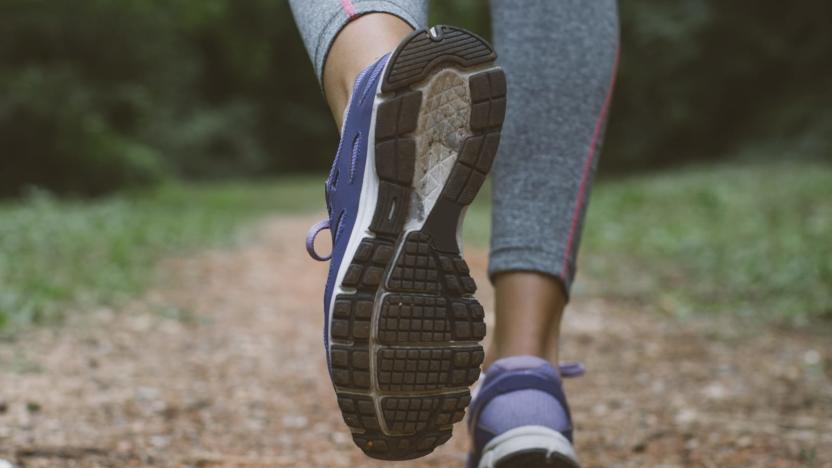
Self-repairing shoes may be a reality thanks to 3D-printed rubber
Shoes will invariably wear out with enough use, but scientists might have found a way to delay the shopping trip for their replacements. A USC team has created a self-healing 3D-printed rubber that could be ideal for footwear, tires and even soft robotics. The effort involves 3D printing the material with photopolymerization (solidifying a resin with light) while introducing an oxidizer at just the right ratio to add self-healing properties without slowing down the solidifying process.
Jon Fingas02.06.2019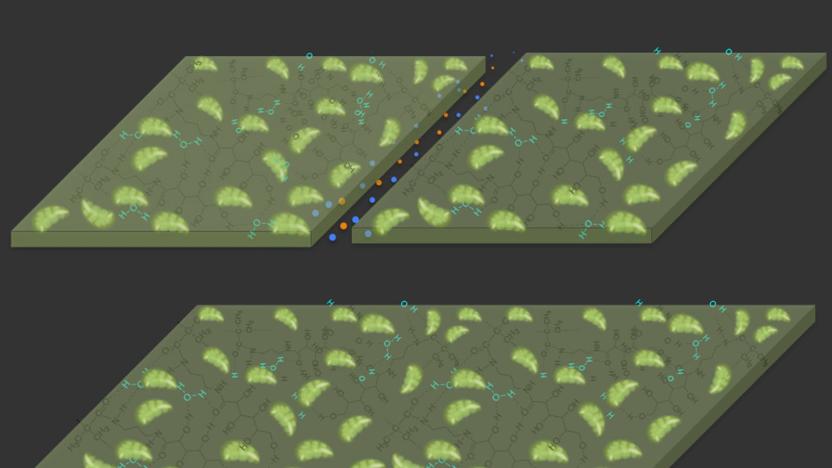
Self-repairing material plucks carbon from the air
Scientists might have a particularly clever way to help the environment: they've developed a material that can not only heal itself, but could reduce CO2 levels in the process. The substance uses its combination of a gel-like polymer with chloroplasts (cell elements that handle photosynthesis in plants) to grow by snatching carbon from the air after exposure to light. If you cracked or scratched an already-solidified piece of this material, the newly exposed sides would promptly expand and fill the gap without requiring heat, ultraviolet light or other special reactions like you see with existing self-healing products.
Jon Fingas10.14.2018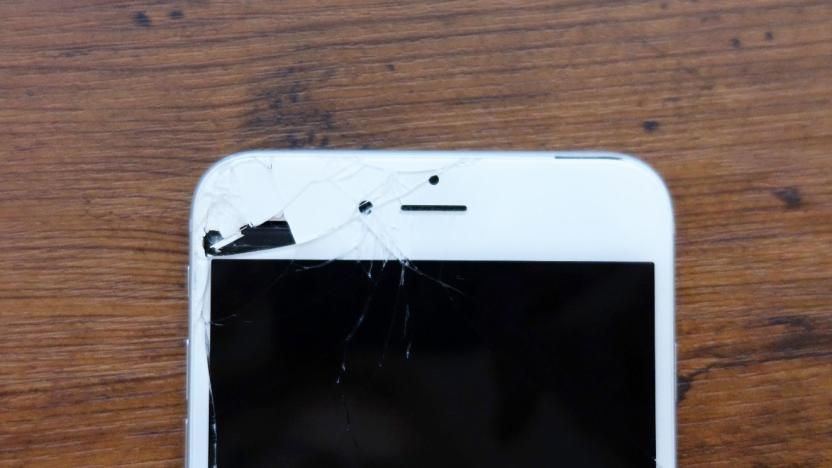
A new polymer could make phone screen repairs a thing of the past
If you've ever had to deal with a cracked smartphone screen, you know what a hassle it can be. Slapping a screen protector on it is only a stopgap until you have to have the screen replaced, which comes with a decent price tag. Now, researchers in Tokyo have discovered a new polymer that may actually heal itself, potentially leading the way to a future of self-healing phone screens.
Rob LeFebvre12.18.2017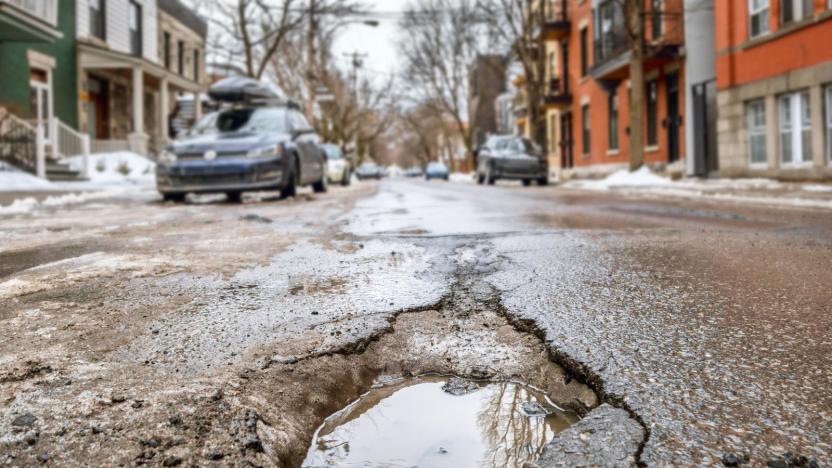
Self-repairing roads could also charge your electric car
Potholes are bad enough for the jarring rides, car damage and safety hazards they create, but it's also problematic to fix them. You're looking at lane and road closures that can last for days, assuming the city can even spare the resources. However, Dutch researchers might have a solution that not only helps the road fix itself, but promises to solve range anxiety for electric car drivers. Delft University's Erik Schlangen tells The Verge that there are plans to test self-repairing asphalt whose conductive steel fibers and bacteria would both fix small cracks in the pavement and send electricity to EVs above. The trial will charge your vehicles when you're stopped at intersections, giving you a little bit of extra range in those moments you're waiting for the light to turn green.
Jon Fingas05.07.2017
Future wearables could use magnetic circuits to self-heal
Smart clothing might be huge, except for one problem: The printed "ink" electronics are delicate, so you can break them just by stretching the wrong way. However, researchers from the Jacobs School of Engineering have developed a self-healing magnetic ink that can repair multiple cuts in as little as 50 milliseconds. That could eventually yield batteries, electrochemical sensors and wearable electronic circuits that fix themselves autonomously, making the smart textile industry more feasible.
Steve Dent11.03.2016
Squid protein makes textiles self-healing
You might be able to repair your ripped jeans one day just be adding water, thanks to a breakthrough from Penn State researchers. Based on its earlier research on self-healing plastics, the team turned squid teeth proteins (yep) into a liquid form using yeast and bacteria, then used it to coat cotton, wool and other fabrics. If the material is torn, you just need to put the edges together, apply warm water and it magically "heals," as flexible and strong as before -- even after being laundered.
Steve Dent08.12.2016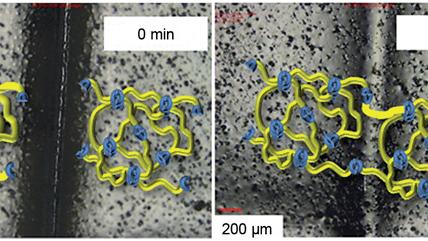
This plastic could make paint scratches a thing of the past
Self-healing plastics are nothing new. In fact, IBM stumbled across the discovery of one such polymer by accident not too long ago. But now there's a new Wolverine-like plastic stealing the headlines (okay, fine... 'science journal' headlines) and this time it hails from researchers at the University of Reading in the UK. The supramolecular polyurethane, developed with funding from the Engineering and Physical Sciences Research Council, reportedly repairs itself at body temperature (98.6 degrees F or 37 degrees C). The new material's unique properties allow it to "[flow] like a liquid" when its bonds are disrupted and reform, as its viscosity is lowered when damaged.
Joseph Volpe04.08.2016
Watch this self-healing material handle a bullet
NASA-funded research has created a material that could self-heal in seconds. Two layers of solid polymer sandwich a gel that with an ingredient that solidifies on contact with air (i.e. when one or both of the outer layers is damaged). This differs from other approaches that rely on a mostly-liquid compound, or similar, slower techniques. The protective applications in space craft (like the ISS) are obvious, and could add a vital line of defense against dangerous debris. The ISS already has shields to protect it, but reactive armour in the event of damage would be even more reassuring. Back down here on earth, the same material could be used in cars, pips, containers and even phones (beyond scratches). Watch the material get shot and self-heal in the video below.
James Trew08.28.2015
Innerexile's iPhone 6 case can heal from light scratches
We've seen LG flaunting the self-healing coating on its rather peculiar G Flex, but wouldn't it be nice to have this on other phones? Well, Innerexile's Hydra plastic case for the iPhone 6 offers a similar feature. We say "similar," because the hard yet resilient Hydra is apparently able to recover from a heavier bronze brush scratch test -- 1kg instead of the G Flex's 750g -- as well as strong bending in the lab. I received a couple of samples to play with and while I don't have the same testing equipment, I can still attest to the cases' impressive build quality, glossy finish and flexural strength -- as shown in my hands-on video after the break. But as with the G Flex, the Hydra's patented self-healing coating is meant for light scratches only.
Richard Lai09.12.2014
How a water bottle gave birth to a whole new world of self-healing products
IBM's had a breakthrough in accelerated materials science and it's owed, in part, to a Dasani water bottle. It sounds simplistic, but the discovery of a new polymer that's not only super strong, but can also be made to be flexible and self-healing really was the happy accident of one researcher's focus on "green" chemistry and recyclable materials (i.e., plastic water bottles). Dr. Jeannette Garcia, a principal researcher for the project, was in the lab experimenting with the creation of high-performance materials when she stumbled upon this new polymer. "I made an error weighing out one of my starting materials and found that... [the new material] plugged up," she said. That resulting substance was so tightly bonded, Garcia had to smash the flask with a hammer just to get it out. She also tried hitting the substance with the hammer to see if it would break. It didn't.
Joseph Volpe05.15.2014
Self-healing plastic bleeds when cut, and that's a good thing
Wouldn't it be great if everything was as good at healing itself as our own skin? That's the concept behind a new self-healing plastic that's been developed over at the University of Illinois at Urbana-Champaign. Unlike ordinary plastics, this one contains a thin network of tubes, aping the human vascular system, containing two separate gels that react when they come into contact with each other. When the surface of the plastic is punctured, for instance if shot by a bullet, the two gels pour out, mixing to form a surface roughly 60 percent as strong as the original -- just like a blood clot would on our bodies.
Daniel Cooper05.11.2014
Caltech self-healing chips can recover from laser blasts, save power while healthy
While many scientists have heard the call for self-healing electronics, their previous projects have usually had just a limited capacity to come back from the brink. Caltech has developed an integrated circuit that could take much more of a bruising. Its prototype power amplifier chip has a dedicated circuit and sensors that can change actuators in microseconds if there's damage, re-optimizing the connections on the spot. And the chip can take a lot of that damage -- 76 examples in a penny-sized cluster endured multiple laser strikes in tests (like the one above) while still ticking. The self-healing even helps while everything is in tip-top shape, as it can cut power use by watching for the usual hiccups in load and voltage. So long as Caltech can develop the technology beyond its currently expected niches of communication and imaging, many of our computing devices could eventually take a few bumps and scrapes on the inside, not just their rugged exteriors.
Jon Fingas03.09.2013
Where does the pressure lie in healing?
I used to be a healer, once upon a time. It was in the days of vanilla, when being a healer consisted largely of staring at 40 bars, pressing Flash Heal, and occasionally mixing it up with a bubble or Heal Rank 4 while swigging potions like they were going out of style. It was a very different time, and healing was by and large much less complex than it is today. My guild didn't use Vent, so I did all the healing rotation calls via macros on my keyboard -- that's how easy healing was. I had time to press macro buttons and pay attention to calling things. But at some point that guild fell apart, as guilds are wont to do on occasion. And since server transfers weren't even a possibility at that point in time, I simply rolled another character on another server, vowing to take a break from any and all raiding. It lasted until paid server transfers were added as a feature, at which point my priest was promptly moved to my new server and I began healing again -- this time, in battlegrounds. I helped a lot of friends by healing them while they tried their hardest to get High Warlord in the original honor grind. So what happened? Well ... healing happened.
Anne Stickney12.08.2012
Blood Pact: Staying slightly alive as a warlock
Every week, WoW Insider brings you Blood Pact for affliction, demonology, and destruction warlocks. This week, Megan O'Neill completely devours a real-life box of cookies while listing out all the ways a warlock can heal herself. Om nom nom. Dead DPS does zero DPS. We all know that saying. I introduce to you my Princess Bride collorary to the Dead DPS rule: Miracle Max: Whoo-hoo-hoo, look who knows so much. It just so happens that your friend here is only MOSTLY dead. There's a big difference between mostly dead and all dead. Mostly dead is slightly alive. With all dead, well, with all dead there's usually only one thing you can do. Inigo Montoya: What's that? Miracle Max: Go through his clothes and look for loose change. The perfect description of what happens when a mob dies in an RPG aside, Miracle Max is right: mostly dead is slightly alive, and slightly alive means you can still do more damage. Naturally -- since we are magnificent, resilient bastards instead of glass cannons -- warlocks are quite excellent at staying slightly alive.
Megan O'Neill11.19.2012
Stanford self-healing plastic responds to touch, keeps prosthetics and touchscreens in one piece
Self-healing surfaces are theoretically the perfect solutions to easily worn-out gadgets, but our dreams come crashing down as soon as deliberate contact is involved; as existing materials don't conduct electricity, they can't be used in capacitive touchscreens and other very logical places. If Stanford University's research into a new plastic polymer bears fruit, though, our scratched-up phones and tablets are more likely to become distant memories. The material can heal within minutes of cuts through fast-forming hydrogen bonds, rivaling some of its peers, but also includes nanoscopic nickel particles that keep a current flowing and even respond to flexing or pressure. The material is uniquely built for the real world, too, with resilience against multiple wounds and normal temperatures. While the polymer's most obvious use would be for mobile devices whose entire surface areas can survive the keys in our pockets, Stanford also imagines wires that fix themselves and prosthetic limbs whose skin detects when it's bent out of shape. As long as we can accept that possible commercialization is years away, there's hope that we eventually won't have to handle our technology with kid gloves to keep it looking pretty.
Jon Fingas11.12.2012
SLIPS liquid repeller is inspired by carnivorous plants, enemy to insects and graffiti artists alike
When a team of Harvard researchers wanted to create the ultimate liquid- and solid-repelling surface, they looked toward the Nepenthes pitcher plant, where curious insects check in and never check out, thanks to slippery walls that lead to their tiny, horrific fate. The tropical plant inspired the creation of SLIPS (Self-healing, Slippery Liquid-Infused Porous Surface), a synthetic material that utilizes nano/ microstructured substrates, capable of repelling just about anything you can throw at it. During a visit to the hallowed Crimson halls, the team was kindly enough to show off the material through a series of messy, messy demos, dropping water, motor oil, liquid asphalt and newly-mixed concrete on aluminum and glass. The team even went crazy with a can of black spray paint, comparing the results to a Teflon surface. The outcome was the same in all case -- an amazingly repellent material. The team has published a number of papers on the stuff, including ones that demonstrate its ice- and bacteria-repelling properties. Oh, and like its natural inspiration, SLIPS does a great jobs keeping bugs off its surface. You can check out our demos and one unhappy ant filmed by the SLIPS team. No insects were harmed in the making of our video, at least -- and the lab assures us that ant had a good life before learning the hard way why it shouldn't mess with Harvard scientists.
Brian Heater08.03.2012
Graphene heals itself, powers our dreams and nightmares
Slowly, but surely graphene is pushing our technological hopes, dreams and, yes, nightmares towards reality. The stuff is capable of extending battery life, generating electricity, powering high-speed data connections and super computer-worthy CPUs. It's water proof, stretchy, bendy and apparently self healing. (This space reserved for T-1000 reference.) Researchers at the University of Manchester discovered that, if you put a hole in a sheet of graphene, it simply stitches itself back together. This is thanks to carbon's tendency to latch on to other atoms, including its own, which can make the futuristic material difficult to work with, but gives it this highly unique quality. Thankfully, we're no where near self-healing robots. But, the discovery could lead to a simple method for molding it into almost any shape. Once pierced, the form of the mend is determined by the type of molecules introduced -- pure carbon simply regrows the perfect honeycomb structure, while a few foreign atoms can lead to "defects." Of course, if they're intentional and predictable, defects merely become "features." For more check out the source link.
Terrence O'Brien07.10.2012
Click the Lightwell -- no, really ...
I like to think I'm a decent rogue. My DPS is pretty good, I know my rotation like the back of my hand, and I've got orange weapons with which to stab things. More important than that (to me, anyway) is the fact that I use self-heals almost religiously, without thinking about it. I think a good portion of that comes from having been a healer originally and having an understanding about healing and just how difficult it is. I don't want to make it more difficult; I just want to happily stab things. In order to do that effectively, I need to not die. That said, I love Lightwell. It's a nice little spell that priests toss on the ground, and you click it to use it. Earlier versions of Lightwell were a little clunky and difficult to use, but today's version is pretty streamlined. I don't lose my target if I click the Lightwell, and I don't have to be on top of the thing to click it. It's a handy little heal to have, much like a Healthstone or even Recuperate. Since I'd rather be using DPS-boosting potions than healing potions, I'll take any little heals I can get. Oddly enough, not everyone does. And I can't quite figure out why.
Anne Stickney04.19.2012
Toray unveils new self-repairing film for devices, fixes scratches in under 10 seconds
Toray's advanced film department has finished its new self-cure coating and is set to start using it as a decorative layer on a series of as-yet unannounced notebooks. Fortunately, the company is already chasing down more pervasive uses on smartphones and touch-panels. The science involves a wet coating method that adds a special recovering layer to PET film. Alongside that mutant healing factor, the layer responsible also throws in some elastic and cushioning properties. During Toray's demonstration (what, no video?) scratches made with a metal brush apparently repaired themselves, resulting in the rehabilitated glossy surface you see above. According to the Japanese manufacturer, the ability to heal improves at lower temperatures, but room temperature is apparently enough to make scratches disappear in 10 seconds or less -- more than fast enough to differentiate Toray's offering from existing solutions. The film can repair itself around 20,000 times in succession, although if pierced beyond the layer, it's -- unsurprisingly -- unable to recover any damage done. The screen is also softer than the typical protective surfaces found to devices. Maybe Toray and Gorilla Glass should get together. GorillToray?
Mat Smith04.06.2012